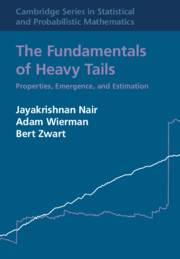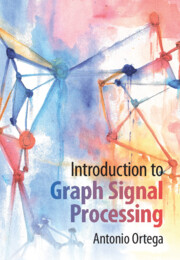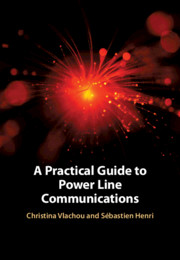Refine search
Actions for selected content:
6829 results in Communications and signal processing

The Fundamentals of Heavy Tails
- Properties, Emergence, and Estimation
-
- Published online:
- 17 May 2022
- Print publication:
- 09 June 2022

Introduction to Graph Signal Processing
-
- Published online:
- 09 May 2022
- Print publication:
- 09 June 2022

A Practical Guide to Power Line Communications
-
- Published online:
- 05 May 2022
- Print publication:
- 19 May 2022
11 - Information Theoretic Perspectives on Nonorthogonal Multiple Access (NOMA)
- from Part II - Coding and Modulation
-
- Book:
- Information Theoretic Perspectives on 5G Systems and Beyond
- Published online:
- 19 April 2022
- Print publication:
- 05 May 2022, pp 394-425
-
- Chapter
- Export citation
16 - Cooperative Cellular Communications
- from Part III - Protocols
-
- Book:
- Information Theoretic Perspectives on 5G Systems and Beyond
- Published online:
- 19 April 2022
- Print publication:
- 05 May 2022, pp 581-635
-
- Chapter
- Export citation
12 - Compute–Forward Strategies for Next–Generation Wireless Systems
- from Part II - Coding and Modulation
-
- Book:
- Information Theoretic Perspectives on 5G Systems and Beyond
- Published online:
- 19 April 2022
- Print publication:
- 05 May 2022, pp 426-462
-
- Chapter
- Export citation
3 - Device-to-Device Communication
- from Part I - Architecture
-
- Book:
- Information Theoretic Perspectives on 5G Systems and Beyond
- Published online:
- 19 April 2022
- Print publication:
- 05 May 2022, pp 95-130
-
- Chapter
- Export citation
14 - Concluding Remarks
- from Part III - Further Properties of Hybrid Iterative Algorithms and Suggestions for Improvement
-
- Book:
- Geometry of the Phase Retrieval Problem
- Published online:
- 21 April 2022
- Print publication:
- 05 May 2022, pp 292-296
-
- Chapter
- Export citation
Index
-
- Book:
- Geometry of the Phase Retrieval Problem
- Published online:
- 21 April 2022
- Print publication:
- 05 May 2022, pp 263-308
-
- Chapter
- Export citation
Frontmatter
-
- Book:
- Information Theoretic Perspectives on 5G Systems and Beyond
- Published online:
- 19 April 2022
- Print publication:
- 05 May 2022, pp i-iv
-
- Chapter
- Export citation
Part I - Architecture
-
- Book:
- Information Theoretic Perspectives on 5G Systems and Beyond
- Published online:
- 19 April 2022
- Print publication:
- 05 May 2022, pp 93-94
-
- Chapter
- Export citation
10 - Short-Packet Transmission
- from Part II - Coding and Modulation
-
- Book:
- Information Theoretic Perspectives on 5G Systems and Beyond
- Published online:
- 19 April 2022
- Print publication:
- 05 May 2022, pp 339-393
-
- Chapter
- Export citation
18 - A Broadcast Approach to Fading Channels under Secrecy Constraints
- from Part III - Protocols
-
- Book:
- Information Theoretic Perspectives on 5G Systems and Beyond
- Published online:
- 19 April 2022
- Print publication:
- 05 May 2022, pp 653-682
-
- Chapter
- Export citation
5 - Edge Caching
- from Part I - Architecture
-
- Book:
- Information Theoretic Perspectives on 5G Systems and Beyond
- Published online:
- 19 April 2022
- Print publication:
- 05 May 2022, pp 166-192
-
- Chapter
- Export citation
9 - Massive MIMO and Beyond
- from Part II - Coding and Modulation
-
- Book:
- Information Theoretic Perspectives on 5G Systems and Beyond
- Published online:
- 19 April 2022
- Print publication:
- 05 May 2022, pp 299-338
-
- Chapter
- Export citation
8 - The Discrete, Classical, Phase Retrieval Problem
- from Part II - Analysis of Algorithms for Phase Retrieval
-
- Book:
- Geometry of the Phase Retrieval Problem
- Published online:
- 21 April 2022
- Print publication:
- 05 May 2022, pp 147-190
-
- Chapter
- Export citation
8 - Polarization and Polar Coding
- from Part II - Coding and Modulation
-
- Book:
- Information Theoretic Perspectives on 5G Systems and Beyond
- Published online:
- 19 April 2022
- Print publication:
- 05 May 2022, pp 267-298
-
- Chapter
- Export citation
Part III - Further Properties of Hybrid Iterative Algorithms and Suggestions for Improvement
-
- Book:
- Geometry of the Phase Retrieval Problem
- Published online:
- 21 April 2022
- Print publication:
- 05 May 2022, pp 221-222
-
- Chapter
- Export citation
5 - Some Preliminary Conclusions
- from Part I - Theoretical Foundations
-
- Book:
- Geometry of the Phase Retrieval Problem
- Published online:
- 21 April 2022
- Print publication:
- 05 May 2022, pp 103-106
-
- Chapter
- Export citation
17 - Service Delivery in 5G
- from Part III - Protocols
-
- Book:
- Information Theoretic Perspectives on 5G Systems and Beyond
- Published online:
- 19 April 2022
- Print publication:
- 05 May 2022, pp 635-652
-
- Chapter
- Export citation
